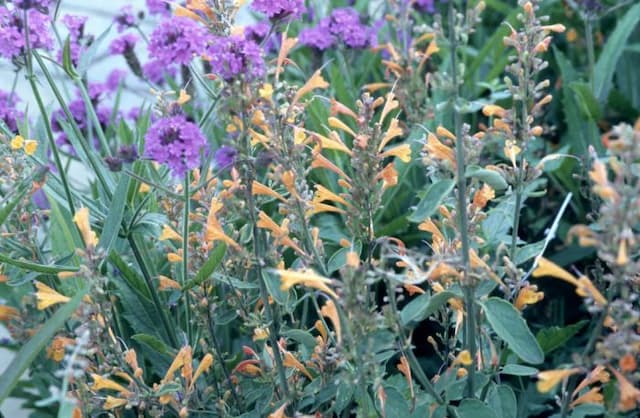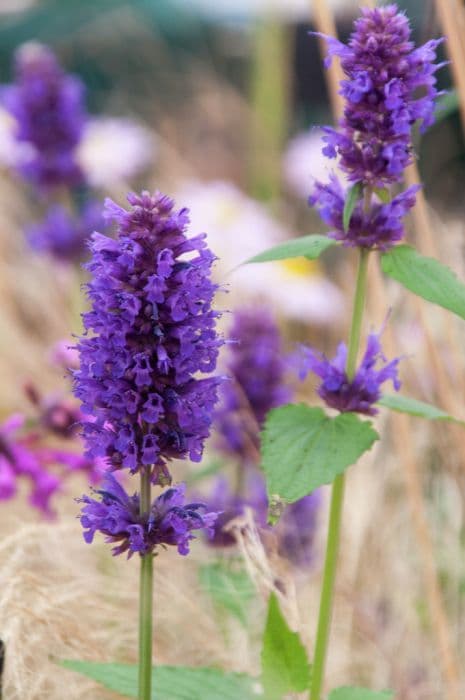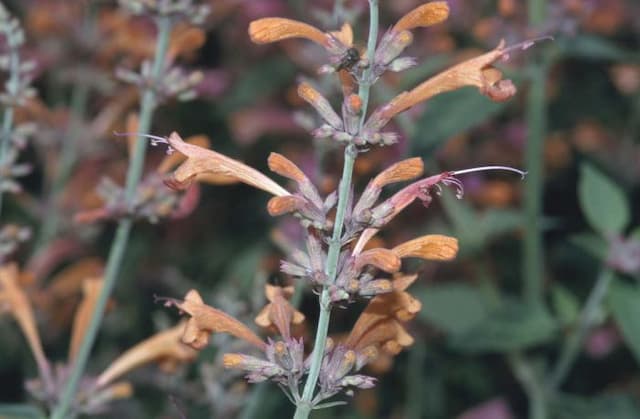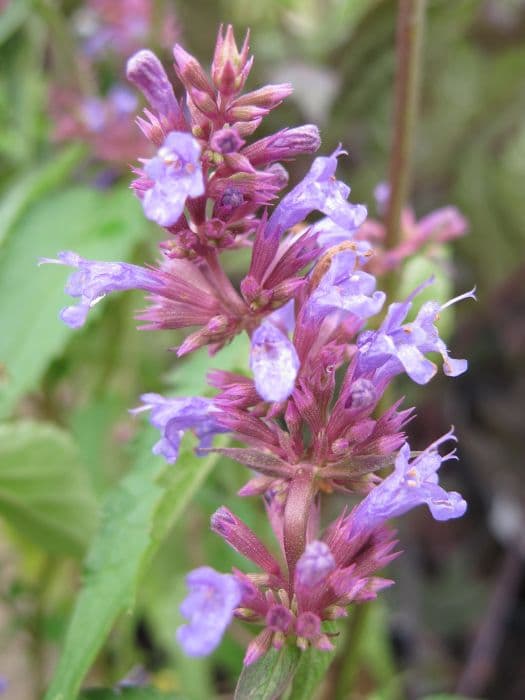Pineapple Mint Mentha suaveolens 'Variegata' (v)

ABOUT
The Variegated Apple Mint is an aromatic herb that is known for its eye-catching foliage and pleasant scent. This perennial plant features leaves that are adorned with a striking pattern of cream or white and green. The variegation can cause the leaves to appear as if they're edged with a creamy white border or sprinkled with irregular white spots, providing a visual contrast that makes this plant stand out in any garden setting. The leaves of the Variegated Apple Mint are also characterized by their texture; they are fuzzy to the touch, giving them a soft, velvety feel. This tactile quality adds another layer of interest to the plant. In addition to the variegated leaves, this mint produces small, pale lavender to pinkish flowers that cluster in rounded, dense heads, further enhancing its ornamental appeal. These flowers can attract pollinators such as bees and butterflies. Beyond its beauty, the Variegated Apple Mint is noted for its fragrance. The plant emits a sweet, fruity scent reminiscent of apples, which is especially pronounced when the leaves are crushed or brushed against. This mint variety can spread through rhizomes and can be used in culinary applications, much like other mints, to add flavor to dishes and beverages. With its combination of visual charm and aromatic qualities, the Variegated Apple Mint is a delightful addition to both herb gardens and landscape designs where it can provide both aesthetic value and function.
About this plant
 Names
NamesSynonyms
Pineapple Mint, Variegated Apple Mint.
Common names
Mentha rotundifolia 'Variegata', Mentha macrostachya, Mentha insularis
 Toxicity
ToxicityTo humans
Apple mint, as Mentha suaveolens 'Variegata' is commonly known, is generally regarded as non-toxic to humans. The plant is often used in culinary applications for its fragrant leaves. There are no well-documented cases of toxicity or poisoning from ingesting this plant in humans. As with any plant, individual allergies or sensitivities can exist, so ingestion should be with caution if you're unsure of your reactions.
To pets
Apple mint is also generally considered non-toxic to pets. It is not known to cause serious harm if a pet, such as a dog or cat, ingests the leaves. However, as with any substance, ingestion in large quantities could potentially cause gastrointestinal upset, such as vomiting or diarrhea. Pets might also be susceptible to the same individual allergies or sensitivities as humans, so monitor your pets for any unusual symptoms after ingestion.
 Characteristics
CharacteristicsLife cycle
Perennials
Foliage type
Evergreen
Color of leaves
Mixed
Flower color
Lilac
Height
1-2 feet (0.3-0.6 meters)
Spread
1-2 feet (0.3-0.6 meters)
Plant type
Herb
Hardiness zones
5
Native area
Europe
Benefits
 General Benefits
General Benefits- Aesthetic Appeal: Mentha suaveolens 'Variegata' or Pineapple Mint, has variegated leaves that add visual interest to gardens with its patterned green and cream or white foliage.
- Culinary Use: The leaves of Pineapple Mint can be used to flavor teas, beverages, salads, and desserts, adding a refreshing taste similar to mint with a hint of pineapple.
- Fragrance: This plant emits a pleasant, minty-pineapple fragrance when its leaves are brushed or crushed, which can be enjoyed in gardens or when the leaves are used indoors.
- Easy to Grow: Pineapple Mint is a hardy and vigorous plant that is easy to grow, making it ideal for beginner gardeners or those with less experience in plant care.
- Attracts Pollinators: The flowers of Pineapple Mint are attractive to bees and other pollinators, which is beneficial for the garden ecosystem.
- Herb Garden Addition: As a versatile herb, Pineapple Mint is a valuable addition to any herb garden where it can be harvested for various uses.
- Edging and Borders: Due to its moderate growth habit, Pineapple Mint is suitable for edging and creating decorative borders in garden settings.
- Companion Planting: Pineapple Mint can serve as a companion plant helping to repel certain pests from the garden.
- Container Gardening: Suitable for pots and containers, Pineapple Mint can be grown on patios, balconies, or indoors where space is limited.
 Medical Properties
Medical Properties- Antispasmodic: May help relieve spasms of the digestive tract.
- Carminative: Can be used to reduce gas and bloating.
- Antimicrobial: Contains compounds that may inhibit the growth of bacteria and fungi.
- Analgesic: Could be beneficial in alleviating minor aches and pains.
- Anti-inflammatory: Might assist in reducing inflammation.
 Air-purifying Qualities
Air-purifying QualitiesThis plant is not specifically known for air purifying qualities.
 Other Uses
Other Uses- Mentha suaveolens 'Variegata' can be used to create a naturally scented sachet, which when placed in drawers or closets can provide a pleasant aroma and may deter moths.
- The leaves of Pineapple Mint can be incorporated into potpourri mixes to add a unique fragrance and visual appeal with its variegated leaves.
- Pineapple Mint can be dried and used as a decorative element in homemade candles for a subtle scent and attractive garnish.
- Used as a natural dye, the leaves of Pineapple Mint can impart a gentle green hue to fabrics or homemade soaps.
- The plant can be used in crafting, where its leaves are pressed and included in paper making or botanical prints for a delightful mint imprint.
- Pineapple Mint is ideal for creating a living mulch in the garden, which suppresses weeds and keeps the soil moist and cool.
- When planted in and around vegetable gardens, Pineapple Mint can help to repel certain pest insects, fostering a more organic approach to pest control.
- Tossed into a warm bath, the fragrant leaves of Pineapple Mint can make for a refreshing and invigorating herbal bath soak.
- This plant can be shaped into a decorative topiary, providing both an edible landscape feature and an attractive green sculpture.
- Pineapple Mint clippings can be used for natural craft projects, such as wreath-making, bringing a fresh look and scent to homemade decor.
Interesting Facts
 Feng Shui
Feng ShuiThe Apple Mint is not used in Feng Shui practice.
 Zodiac Sign Compitability
Zodiac Sign CompitabilityThe Apple Mint is not used in astrology practice.
 Plant Symbolism
Plant Symbolism- Refreshing: As a variation of mint, the Apple Mint (Mentha suaveolens 'Variegata') is associated with freshness and its cooling flavor symbolizes a refreshing presence and rejuvenation.
- Hospitality: Mint has long been seen as a symbol of hospitality, welcoming and friendship. Traditionally, mint was used to clean the table before guests arrived as a sign of hospitality.
- Healing: Mint is known for its medicinal properties, so it often symbolizes health, healing and it has been used in traditional remedies for nausea and other digestive issues.
- Cleansing: Its clean and crisp scent has also been associated with purification and cleansing both physically and spiritually.
- Protection: In folklore, mint was used to ward off evil spirits and was placed in homes for protection.
- Love and Virtue: In some cultures, mint represents love and virtue, and carrying a mint leaf was believed to ensure a safe journey.
 Water
WaterThe Pineapple Mint should be watered when the top inch of soil feels dry to the touch, typically once a week. However, during hot, dry periods, you may need to water more frequently, possibly every few days. Use lukewarm water and water thoroughly, allowing excess to drain away, which should amount to approximately 1-2 gallons for an outdoor plant or a few ounces for a potted plant every week, depending on plant size and environmental conditions. Avoid waterlogging as this can lead to root rot. Always check the soil moisture level before watering to ensure the plant is not being overwatered.
 Light
LightPineapple Mint thrives best in full sun to partial shade. Place it in a location where it receives at least 4-6 hours of sunlight daily. If grown indoors, a sunny window or a spot with bright, indirect light is ideal for this mint variety.
 Temperature
TemperaturePineapple Mint prefers a relatively warm climate with temperatures ideally between 65°F and 70°F. It can tolerate a minimum temperature of around 50°F and can also withstand warmer temperatures up to about 80°F, as long as the plant is not exposed to extreme heat for prolonged periods.
 Pruning
PruningPruning Pineapple Mint is necessary to promote bushier growth and prevent the plant from becoming leggy. Trim back the stems by one-third in early spring or after the plant has flowered to encourage new growth. Pruning should be done periodically throughout the growing season, as needed, to maintain plant health and appearance.
 Cleaning
CleaningAs needed
 Soil
SoilVariegated Apple Mint prefers well-draining, moisture-retentive soil with a pH between 6.0 and 7.0. A soil mix containing equal parts potting soil, compost, and perlite or sand would provide the nutrients and drainage it needs.
 Repotting
RepottingVariegated Apple Mint should be repotted every one to two years, or when it outgrows its container. As a fast grower, division during repotting can help control its size and rejuvenate the plant.
 Humidity & Misting
Humidity & MistingVariegated Apple Mint thrives in moderate humidity levels, but is adaptable and can tolerate the lower humidity levels often found in home environments.
 Suitable locations
Suitable locationsIndoor
Provide bright light, moist soil, and air circulation.
Outdoor
Plant in partial shade, keep soil moist, and space 18 inches apart.
Hardiness zone
5-9 USDA
 Life cycle
Life cycleMentha suaveolens 'Variegata', commonly known as variegated pineapple mint, begins its life cycle as a seed, which germinates in moist, well-drained soil with partial to full sunlight exposure. Upon sprouting, the seedling develops into a young plant with variegated leaves, demonstrating the characteristic cream or yellow edges. As it matures, the plant forms a network of rhizomes, spreading horizontally and enabling vegetative propagation and clump formation. In its adult stage, pineapple mint produces small, pink or white flowers in the summer, attracting pollinators to its aromatic blossoms. After flowering, it sets seed, which can be dispersed by wind or animal activity, completing the reproductive cycle. The plant is a perennial and will continue this cycle annually, with foliage dying back in winter and regrowth in the spring, given proper care and environmental conditions.
 Propogation
PropogationPropogation time
Spring-Early Summer
Mentha suaveolens 'Variegata', commonly known as Pineapple Mint due to its fruity scent and attractive foliage, can be effectively propagated through stem cuttings. This is a popular method due to its simplicity and high success rate. In spring or early summer, when the plant is actively growing, a cutting of about 4 to 6 inches (10 to 15 cm) long should be taken from a healthy stem. The lower leaves are removed, and the cut end is dipped in rooting hormone to encourage root development, although this step is not strictly necessary for mint plants which readily root. The cutting is then inserted into a moist soilless potting mix. To ensure a humid environment, a plastic bag or dome can be placed over the container to retain moisture. Within a matter of weeks, the cutting should establish a sufficient root system and can be transplanted to its permanent location.







![Bugle [Black Scallop]](/_next/image?url=https%3A%2F%2Fplants-admin.emdemapps.com%2Fimages%2Fplants%2F%2Fimages%2F604b624330cd1.png&w=640&q=75)

